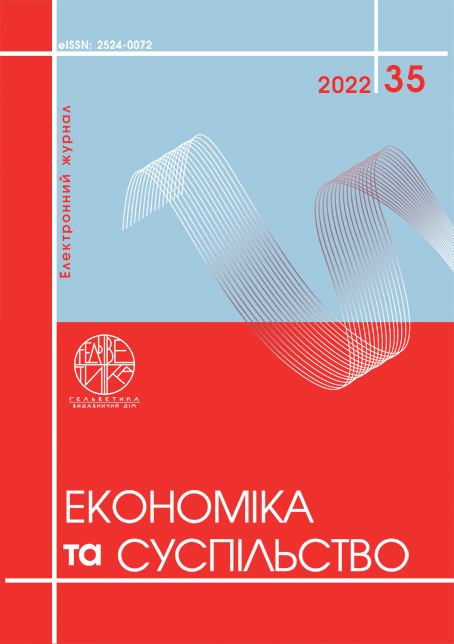ФІНАНСОВИЙ РИЗИК ПРИ ФОРМУВАННІ СТРАТЕГІЇ СТАЛОГО РОЗВИТКУ ПІДПРИЄМСТВА
Анотація
Стаття присвячена теоретичним та практичним аспектам з формуванню програми сталого розвитку при наявності фінансових ризиків на підприємстві. Проаналізовані різні поняття науковців, щодо таких термінів: «ризик», «фінансовий ризик» та «сталий розвиток підприємства». Розглянуто основні складові сталого розвитку підприємства та вплив на нього фінансового ризику. Проаналізовано ринок продуктів сухих сніданків в Україні та рівень фінансового стану досліджуваного підприємства ПрАТ «Лантманнен Акса», Проаналізовано вплив всіх фінансових показників та наявність фінансових ризиків. Запропоновано заходи щодо зниження фінансових ризиків, створено нова програма сталого розвитку ПрАТ «Лантманнен Акса».
Посилання
Beer S., Wiley J. Cybernetics and management. New York, 1968. 214 p.
Freeman, C. The “National System of Innovation” in historical perspective. Cambridge Journal of Economics. 1995. p. 5–24.
Васюк Н.В. Формування механізму стійкого розвитку машинобудівних підприємств. Інноваційна економіка. 2012. C. 125–128.
Гальчак Х.Р. Забезпечення сталого розвитку підприємства як основа формування соціальної відповідальності. Вісник Національного університету "Львівська політехніка". Серія: Проблеми економіки та управління : збірник наукових праць. 2016. C. 69–74.
Демиденко Л.М. Концептуальні підходи до забезпечення стійкого розвитку підприємства. Наукові праці Полтавської державної аграрної академії. 2013. С. 92–96.
Невмержицький Я. Фінансовий ризик та дивідендна політика підприємства. Ринок цінних паперів Україні. 2006. C. 3-4.
Скакальський Ю.С. Контролінг фінансових ризиків підприємств: дис. … канд. ек. наук: 08.00.08. Київ, 2016. 231 c.
Зоріна О.А. Методи аналізу фінансових ризиків. Міжнародний збірник наукових праць. 2011. № 2. С. 221–229.
Лазоренко Т., Шолом І. Теоретичні засади концепції управління стійким розвитком підприємства. Галицький економічний вісник. 2020. №6. С. 175–184.
Штайнхофф Д., Берджес Д. Основы управления малым бизнесом. Москва : БИНОМ, 1997. 495 с.
Грабовый П.Г., Петрова С.Н., Полтавцев С.И. Риски в современном бизнесе. Москва : Аланс, 1994. 200 c.
Дорош О.Б. Основні завдання та напрями аудиту фінансової діяльності підприємства [Електронний ресурс]: збірник/ Наука молода. №12, Київ, 2009. URL: http://www.nbuv.gov.ua/portal/Soc_Gum/Menedzhment/2009_12/Doroch
Державна служба статистики України. URL: http://www.ukrstat.gov.ua/
Тупалсьска О. Коронавірус 2020 та харчова безпека: чи буде Україна з продовольством, а бізнес з гривнею. Агрополіт – гаряча агрополітика. URL: https://agropolit.com/spetsproekty/721-koronavirus-2020-ta-harchova-bezpeka-chi-bude-ukrayina-z-prodovolstvom-a-biznes-z-grivneyu
Шевчук П. Пластівці заходять на територію круп. Економічна правда. URL: https://www.epravda.com.ua/columns/2018/12/14/643517/
Taffler R., Tisshaw H. Going, going, gone – four factors which predict. Accountancy. 1977. pp. 52–55.
Мартиненко В.П. Стратегія життєздатності промислових підприємств: (монографія). Київ : Центр навч. Л-ри. 2006. 324 с.
Altman E.I. Financial Ratios, Discriminant Analysis and the Prediction of Corporate Bankruptcy. The Journal of Finance. 1968. № 4. P. 589-609. DOI: https://doi.org/10.2307/2978933
Beer S., Wiley J. (1968) Cybernetics and management. New York, 214 p.
Freeman C. (1995) The “National System of Innovation” in historical perspective. Cambridge Journal of Economics, p. 5–24.
Vasyuk N.V. (2012) Formuvannya mehanizmu stiykoho pozvitku mashinobudivnyh pidpriemstv. [Formation of the mechanism of sustainable development of machine-building enterprises]. Innovatsiyna ekonomika, no, 10. pp. 125–128. (in Ukrainian)
Halchak H.R. (2016) Zabezpechennya stalogo rozvitku pidpriemstva yak osnova formuvannya sotsialnoyi vidpovidalnosti [Ensuring sustainable development of the enterprise as a basis for the formation of social responsibility]. Visnyk Natsionalnogo universytetu "Lvivska politehnika". Seriya: Problemy ekonomiky ta upravlinnya: zbirnyk naukovykh prats, no 847, pp. 69–74. (in Ukrainian)
Demydenko L.M. (2013) Konceptualni pidhody do zabezpechennya stiykoho rozvitku pidpriemstva [Conceptual approaches to ensuring sustainable development of the enterprise]. Naukovy pratsi Poltavskoyi derzhavnoyi ahrarnoyi akademiyi. Seriya: Ekonomichni nauky, no. 2(7), pp. 92–96. Available at: http://www.pdaa.edu.ua/sites/default/files/nppdaa/7.1/92.pdf (in Ukrainian)
Nevmerzhytskiy Ya. (2006) Finansoviy ryzyk ta dyvidendna polityka pidpryemstva [Financial risk and dividend policy of the enterprise]. Rynok tsinnyh paperiv Ukrayiny, no. 5, pp. 3–4. (in Ukrainian)
Skakalskiy Yu. S. (2016) Kontroling finansovyh ryzykiv pidpryemstv [Controlling financial risks of enterprises]. 231 p. (in Ukrainian)
Zorina O.A. (2011) Metody analizu finansovyh ryzykiv [Methods of financial risk analysis] no. 2(20), pp. 221–229. Available at: http://eztuir.ztu.edu.ua/jspui/bitstream/123456789/4746/1/21.pdf
Lazarenko T., Sholom, I. (2020) Teoretychni zasady koncepciyi upravlinnya stiykum rozvytkom pidpriemstva [Theoretical fundamentals of the concept of managemgent of sustainable enterprise development] Halytskiy ekonomichniy visnyk, no. 6, pp. 175–184. Available at: https://galicianvisnyk.tntu.edu.ua/pdf/67/924.pdf (in Ukrainian)
Shtaynhoff D., Berdzhes, D. (1997) Osnovy upravleniya malym biznesom [Basics of small business management]. Moscow: BINOM, 495 p. (in Russian)
Hraboviy P.G., Petrova S.N., Poltavtsev, S.I. (1994) Riski v sovremennom biznese [Risks in modern business]. Moscow: Alans, 200 p. (in Russian)
Dorosh, O.B. (2009) Osnovni zavdannya ta napryamy audytu finansovoyi diyalnosti pidpriemstva [The main tasks and areas of audit of financial activities of the enterprise]. Available at: http://www.nbuv.gov.ua/portal/Soc_Gum/Menedzhment/2009_ 12/Doroch.htm.
Derzhavna sluzhba statystyky Ukrayiny. Available at: http://www.ukrstat.gov.ua/
Tupalska O. (2020) Koronavirus 2020 ta harchova bezpeka: chy bude Ukrayina z prodovolstvom, a biznes z hrivneyu [Coronavirus 2020 and food security: will Ukraine be with food and business with hryvnia]. Available at: https://agropolit.com/spetsproekty/721-koronavirus-2020-ta-harchova-bezpeka-chi-bude-ukrayina-z-prodovolstvom-a-biznes-z-grivneyu
Shevchuk P. (2018) Plastivtsi zahodyat` na terytoriyu krup [Flakes enter the territory of cereals]. Ekonomichna pravda. Available at: https://www.epravda.com.ua/columns/2018/12/14/643517/
Taffler R., Tisshaw H. (1977) Going, going, gone – four factors which predict. Accountancy, pp. 50–54.
Martynenko V.P. (2006) Strategiya zhittezdatnosti promislovyh pidpryemstv [Sustainability strategy of industrial enterprises]. Kyiv: Tsentr navch. L-ry. 324 p. (in Ukrainian)
Altman E.I. (1968) Financial Ratios, Discriminant Analysis and the Prediction of Corporate Bankruptcy. The Journal of Finance, no. 4, pp. 589–609. DOI: https://doi.org/10.2307/2978933


